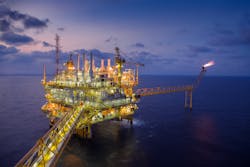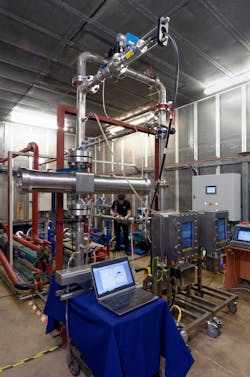Historically, the main areas of application of oil-in-water (OiW) measurement have been for municipal wastewater treatment works, shipping and the oil and gas industry in relation to wastewater treatment process control and optimization, discharged water regulatory compliance monitoring and environmental protection.
The presence of oil can have an adverse effect on the quality of drinking water, with even a tiny amount having a huge impact on taste. Similarly, for sewage treatment works, the presence of oil in trade effluent can have an impact on the treatment process. Consequently, a maximum amount of OiW in trade effluent is usually specified, which in the UK and United States is typically around 100 mg/L.
For the shipping industry, the discharge of bilge water is strictly regulated by the International Maritime Organization (IMO). For treated bilge water, the discharge limit for oil content has been set at 15 ppm (parts per million).
In the upstream oil and gas industry, for every barrel of oil produced there are approximately five barrels of water co-produced. If produced water is to be discharged, regardless of whether it is for offshore or onshore production, the oil content in the discharged produced water must meet a discharge standard set by the regulators around the world. For example, in the North Sea, a monthly average of 30 mg/L as agreed by the OSPAR (Oslo-Paris) Convention, must be met. However, for many of the newer installations a reduced figure is often set and agreed upon between the operator and the corresponding regulatory body/authority of the individual nations.
OiW measurement
Measurement of OiW concentration therefore plays a very important role both for water treatment operations and for discharge regulatory compliance monitoring. It can be measured in a laboratory using a bench-top method or in the field using an online analyzer.
Lab bench-top methods include reference methods — which are important for defining what OiW is and also for regulatory compliance monitoring — and non-reference methods, which are important for process control, optimization and trending. Reference methods include infrared absorption, gas chromatography and flame ionization detection (GC-FID), and gravimetric methods. Non-reference methods may include colorimetric, infrared absorption (based on transmission and horizontal attenuated total reflection), ultraviolet (UV) absorbance and UV fluorescence.
Field measurement methods are often needed for a variety of reasons, including their ease of use, rapid results, low cost, portability and potentially having no requirement for use of solvent and other consumables. In the case of online analyzers, they can provide minute-by-minute (if not second-by-second) data, which is extremely useful for process control and optimization.
Filling the uncertainty knowledge gaps
All measurements have an uncertainty associated, and the measurement of OiW is no exception. The uncertainty of a measurement is defined as the size of the margin of doubt related to the measurement.
For a typical oil-in-produced-water result of 15 mg/L obtained by manual sampling and analysis using the OSPAR GC-FID method, previous estimation carried out at TÜV SÜD National Engineering Laboratory showed that the measurement uncertainty could be as much as ±49% with a 95% confidence. Such a high level of uncertainty could have serious implications to regulatory compliance monitoring, the performance assessment of online OiW analyzers and the development of acceptance criteria for using non-reference OiW measurement methods for discharge reporting.
In the oil and gas industry, online, continuous OiW analyzers have been used for produced water management for many years. However, guidelines for their use for reporting purposes had not been put into practice, checked or verified in the field before being issued.
Also, while there is an increasing interest in developing and deploying normally unattained platforms and subsea separation systems, discharge of significant amounts of produced water from these unmanned installations will not be possible without the availability and use of reliable online OiW analyzers. However, no guidelines currently exist for accepting an online OiW analyzer for reporting the discharge of produced water from such installations.
TÜV SÜD National Engineering Laboratory therefore initiated a joint industry project (JIP) aimed at filling knowledge gaps, making recommendations to update existing guidelines and ultimately making the use of online OiW analyzers for produced water discharge reporting a common practice. The JIP was conducted and completed in 2020 with the support of six international oil and gas operators and the UK Government’s Department for Business, Energy & Industrial Strategy (BEIS). A new JIP has now been initiated, aimed at conducting field trials to ensure that the recommended changes to the existing OSPAR guidelines will be practical and implementable.
The future of OiW analyzers for produced water discharge
OiW is a method-defined parameter, therefore, it is always important to mention the measurement method used when quoting OiW concentration results, and to remember that all measurements have uncertainty associated. However, due to the nature of OiW measurement — mostly wastewater related — few have paid much attention to its uncertainty until recently. Yet, uncertainty is vitally important.
The use of online OiW analyzers has increased in recent years, both for operations and for discharge reporting purposes. As regulators demand ever improved environmental performance and the oil and gas industry seeks to continually reduce operating costs, these benefits mean that online analyzers are likely to become increasingly popular. One of the key issues is the reliable operation of these analyzers — and keeping the analyzer’s optical window clear is vital. Ultrasonic, water jetting and mechanical wiping, as well as methods using fluid dynamics, have been developed and incorporated by the vendors. In the future, we shall increasingly see maintenance based on condition monitoring, which will further improve the reliability of these OiW analyzers.
To make the use of online OiW analyzers for produced water discharge reporting common practice, the knowledge gaps must be closed in relation to analyzer acceptance, measurement uncertainty and guidelines for use of such analyzers for an unmanned platform must be produced. Ongoing research programs will ensure that these gaps are properly addressed through the support and participation of all stakeholders including regulators, operators and vendors.
Ming Yang is a principal consultant at TÜV SÜD National Engineering Laboratory. TÜV SÜD National Engineering Laboratory is a world-class provider of technical consultancy, research, testing and program management services. Part of the TÜV SÜD Group, the organization is also a global center of excellence for flow measurement and fluid flow systems and is the UK’s Designated Institute for Flow Measurement.




